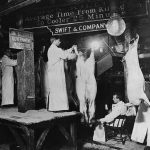On Christmas Day in 1948, 42-year-old biochemist Thomas Jukes came into work to weigh the chickens in his feeding experiment and discovered something unusual. The 25-day chicks fed the highest dose of the antibiotic aureomycin weighed a third more than chickens who didn’t receive the drug. This was the beginning of the use of antibiotics to stimulate growth in the meat and poultry industries.
Jukes worked on animal nutrition for the pharmaceutical company Lederle Laboratories just outside New York City. Lederle concealed the nature of the feed ingredient in its patent application, calling it a vitamin supplement. (Antibiotics were less than a decade old at this time.) In 1951, the U.S. Food and Drug Administration approved without debate the use of six antibiotics in animal feed.
Read more at: “The Chicken Experiment That Shook the World” by Maryn McKenna on the Undark website (2017)






